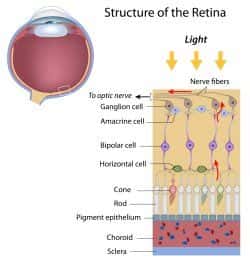Colored contact lenses allow you to temporarily change your eye color whether or not you need to correct impaired vision. In this way, you can create a more subtle eye appearance, wear a crazy design for special occasions, or just enjoy a new eye color. Will Colored Contacts Change the Way I See? Yes,
Read more
Retinal disorders are conditions that affect the layer of tissue at the back of the eye, known as the retina. This important part of the eye responds to light and passes on images to the brain. All retinal disorders affect your vision in some way, but some can also lead to blindness.
Macular degeneration. Also known as age-related macular degeneration (AMD), this condition affects the center part of the retina, the macula. This area is needed for the sharp, central vision that is used during everyday activities such as driving, reading or working with tools. This condition is a leading cause of vision loss in people over the age of 60 years old. Treatment can slow the loss of vision, but it will not restore vision that has already been lost.
Diabetic eye disease. The high blood sugar (glucose) levels that occur with diabetes can also affect vision. One type of diabetic eye disease is diabetic retinopathy, which affects the blood vessels in the retina. This can lead to blurry or double vision, blank spots in the vision and pain in one or both eyes. Diabetics may also be at higher risk of developing other eye conditions, such as cataracts and glaucoma.
Retinal detachment. This medical emergency happens when the retina pulls or lifts off of its normal position. It can cause symptoms such as floaters in the field of vision, light flashes and the feeling of a “curtain” in the way of your vision. If not treated right away, a retinal detachment can lead to permanent blindness in that eye.
Retinoblastoma. This cancer of the retina is generally uncommon; although, it is the most common type of eye cancer in children. The cancer starts in the cells of the retina, but can spread to other parts of the body (metastasize).
Macular pucker. Scar tissue on the macula can make the central vision become blurry and distorted. Although the symptoms are similar, macular pucker is not the same as age-related macular degeneration. The symptoms of a macular pucker are usually mild and do not require treatment. Sometimes, the scar tissue can fall off the retina on its own, and the vision will return to normal.
Macular hole. This condition is caused by a small break in the macula, which leads to blurriness and distortion in the central vision. Related to aging, this condition usually happens in people over the age of 60. Some macular holes close up on their own while others require surgery to help improve vision.
Floaters. These are specks, or “cobwebs,” that appear in the field of vision. Unlike scratches on the cornea, which follow your eye movements, floaters can drift even when the eyes are not moving. Most people have some floaters and have no problem with their vision. A sudden increase in the number of floaters, though, can indicate a more serious eye problem such as retinal detachment.
If you notice a change in your vision or simply have not undergone a routine eye ex
-
Decorative (Plano) Contact LensesCategory: Contact Lenses
-
Wandering EyeCategory: Pediatric Vision
A wandering eye is a type of eye condition known as strabismus or tropia, and it may be caused by damage to the retina or muscles that control the eye, stroke or brain injury, or an uncorrected refractive error like farsightedness. With a wandering eye, one eye deviates or wanders in a different direction
Read more -
Reading and WritingCategory: Pediatric Vision
For many adults, reading and writing come so naturally that they seem almost effortless. However, reading and writing are actually complicated skills that take significant effort to learn. For example, reading involves recognizing letters, associating letter combinations with their corresponding sounds,
Read more -
DyslexiaCategory: Pediatric Vision
Dyslexia When a child has difficulty reading due to problems recognizing speech sounds and learning how they connect to words and letters, the condition is known as dyslexia, a learning disorder caused by genetic traits that disturb how the brain works. It affects areas of the brain dealing with language
Read more -
Crossed EyesCategory: Pediatric Vision
Crossed eyes, also known as strabismus, refer to a condition in which both eyes do not look at the same place at the same time. Often times they both turn in, but may also turn out. What Causes Crossed Eyes? The six muscles attached to each eye, which control how it moves, receive signals from the brain.
Read more -
AutismCategory: Pediatric Vision
Symptoms and Problems Caused By Autism Autism is a neurological disorder in which the person has difficulty processing and reacting to information received from their senses. The individual also has trouble communicating and interacting socially. Signs of autism include: Lack of shared social interaction Postponement
Read more -
ADD/ADHDCategory: Pediatric Vision
Approximately 11% of school-aged children have been diagnosed with attention deficit/hyperactivity disorder (ADHD), according to recent studies. The central symptoms of ADHD -- difficulty sustaining attention, poor control of behavior, hyperactivity -- make it difficult for children to succeed in school.
Read more -
Ocular Motor DysfunctionCategory: Pediatric Vision
Parents are often aware of the need to screen children for nearsightedness or farsightedness, but fewer know about other pediatric vision problems. Ocular motor dysfunction is a condition that often manifests in childhood, although adults may also have this disorder. Because ocular motor dysfunction
Read more -
Convergence InsufficiencyCategory: Pediatric Vision
Convergence insufficiency is a relatively common eye condition that is typically diagnosed in childhood. A study of two large optometry clinics found that 17.6% of children who received vision exams had convergence insufficiency. As this disorder may cause difficulty focusing on written pages, some children
Read more -
Accommodative DysfunctionCategory: Pediatric Vision
Simply put, accommodative dysfunction means that the eyes have difficulty focusing properly. Studies suggest that between 2 and 17% of children may suffer from accommodative dysfunction. The nature of this disorder means that it sometimes goes unnoticed in standard vision screenings conducted at school.
Read more -
Learning-Related Vision ProblemsCategory: Pediatric Vision
Learning disabilities may include dyslexia, math disorder, writing disorder, auditory processing deficits, or visual processing deficits. Although each child with a learning disability is unique, many also have associated visual problems. Addressing these vision disorders may alleviate some symptoms
Read more -
Eye MovementCategory: How the Eyes Work, Basic Visual Skills
Eye movement refers to the voluntary and involuntary movements of the eyes that assist with obtaining, fixating and following visual stimuli. The eyes are each connected to a system of six muscles. Light is sensed by the retina, which is a type of tissue that contains cells known as photoreceptors. These
Read more -
Eye FocusingCategory: How the Eyes Work, Basic Visual Skills
The eyes have a focusing system called accommodation; it allows for visual clarity. The system is rested when you look at an object that is far away and is not forced to strain like it would if the target were close. In normal circumstances, the eyes are able to effortlessly transition between objects
Read more -
Eye CoordinationCategory: How the Eyes Work, Basic Visual Skills
Each eye picks up a slightly different image, but through a process called fusion, the brain blends the images together to make one three-dimensional picture. Good eye coordination is needed, however, and allows the eyes to sustain proper alignment so that they can focus on practically the same image,
Read more -
Technology and VisionCategory: How the Eyes Work
The primary sufferers of technology-related eyestrain used to be adults whose work involved computers. Now, however, people of all ages use computers, smartphones, tablets and gaming devices, which can take their toll on the eyes. As people’s reliance on technology grows, so does the incidence of eyestrain.
Read more -
Eye Anatomy 101Category: How the Eyes Work
The eye has many parts that work together to create vision. The eyes themselves are only part of “seeing.” The brain is also involved. The eyes, though, begin the complex process of vision by gathering, focusing and passing on visual information to the brain. To help you learn how the eye works,
Read more

